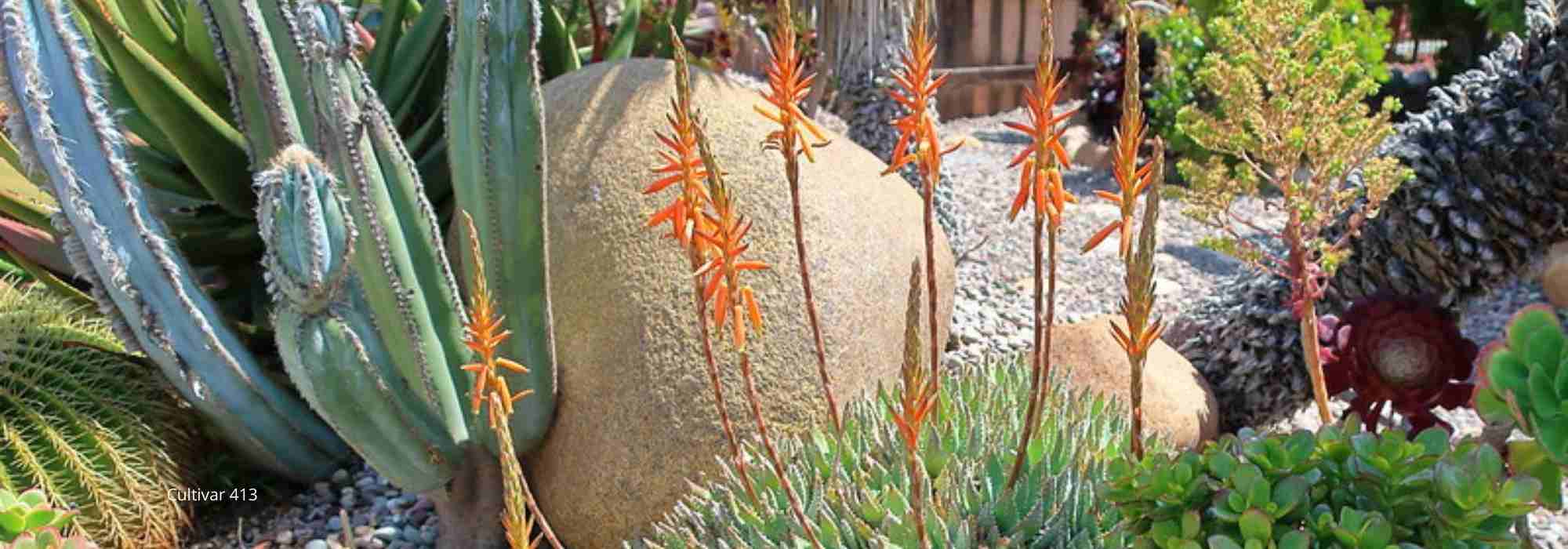
How to create a dry exotic garden?
Our tips to landscape a dry exotic garden
Contents
Designing a dry exotic garden offers a complete escape with Mexican accents, evoking deserts and sun-baked arid landscapes. This mineral-type garden can be created in regions where heat is prevalent for much of the year, with mild temperatures suitable for installing cacti, succulents, and palms that form the basic framework.
Unfortunately, creating a dry exotic garden is not just about gathering dry-land plants, as many Mediterranean species, such as lavender, do not fit into the exotic imagination. Succulent garden, desert-type garden, rock garden, seaside desert garden, rooftop terrace… you can envision a dry exotic garden in contrasting settings, from very contemporary designs to much wilder gardens.
We will tell you everything you need to know before embarking on the creation of a dry exotic garden.
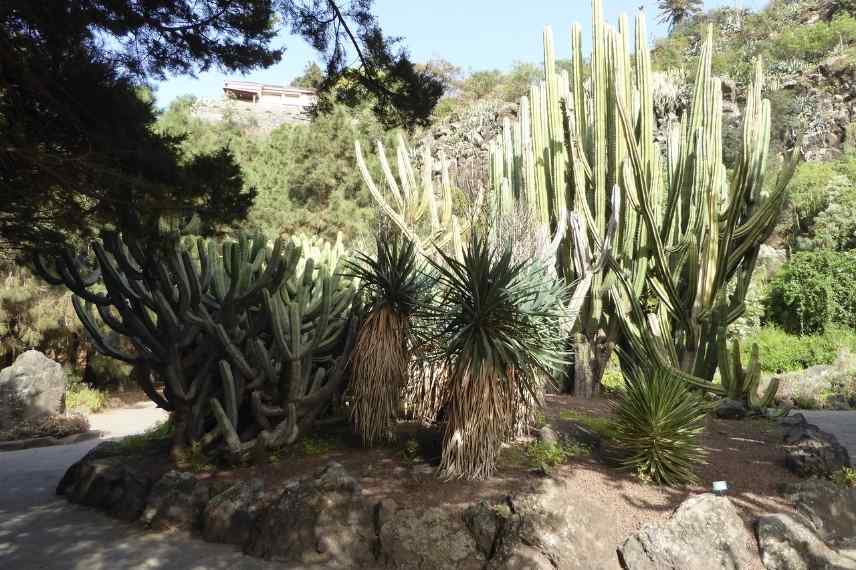
Evocation of desert in this garden composed of xerophytic plants (Botanical garden of Las Palmas, Gran Canaria © Gwenaëlle David Authier)
A few tips before you get started
To replicate the sensation of aridity and desert climate at home, even more so than for the lush exotic garden, there are a few precautions to take and some concepts to remember:
- The climate of your region must not be humid: it will be impossible to maintain dry-land plants in an atmosphere with significant rainfall, due to obvious reasons of soil saturation and inevitable root rot in winter for xerophilous and xerophyte plants.
- If you still wish to create a small dry exotic area in regions less suited for this type of garden, such as Normandy or Northern France, you must raise your bed on a mound, replacing your soil with an ultra-draining substrate made of gravel, rocks, sand, and volcanic stone, to ensure the essential drainage for the longevity of your project. This is feasible in a small space that you can manage.
- In regions where frosts are common, forget about the dream of a dry garden, or design it as a pot garden to winter indoors. You can also start by testing a small area, a bed against a south-facing wall, with a few of the hardiest plants.
- Most of the plants we will discuss have very slow growth. A dry exotic garden will therefore take time to establish, around ten years, which is much longer than a tropical exotic garden. This should be considered according to the scale and timing of your project.
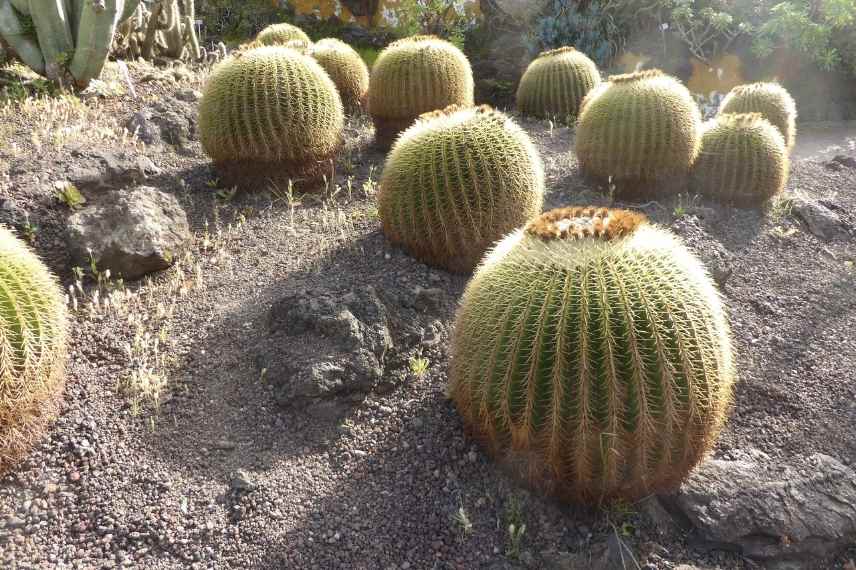
Echinocactus (© Gwenaëlle David Authier)
- A small xerophilous scree garden is ideal for getting hands-on experience with this type of garden: once well-established, the plants will require no special maintenance, and you will increase your chances of success on this highly draining surface.
- Immerse yourself in images of dry exotic countries, such as Mexico, California, and volcanic Mediterranean islands. Draw inspiration from the planting techniques of the Beth Chatto garden located in southern England, which manages to grow plants without watering in its gravel garden.
- You will primarily source from specialised nurseries, but you can easily find a good number of striking plants (Agaves, Dasylirions, Yuccas, houseleeks, as well as many succulents and palms). You will also discover some interesting specimens among indoor plants.
- Finally… while the dry exotic garden has the significant advantage of being easy to maintain once established, its predominantly spiky plants are not suitable if you have young children… In this case, prefer the jungle or tropical exotic garden!
Read also
10 hardy plants for an exotic dry gardenThe Importance of substrate
Creating a dry exotic garden is not something to be done just anywhere! A fundamental rule to ensure the longevity of your garden is to plant it in poor, stony, and ultra-draining soil… otherwise, the plants that thrive there will not withstand the first wet winter, which will condemn their sensitive roots to excess moisture. This is the primary criterion, along with the notion of a warm climate and mild temperatures that must be ensured.
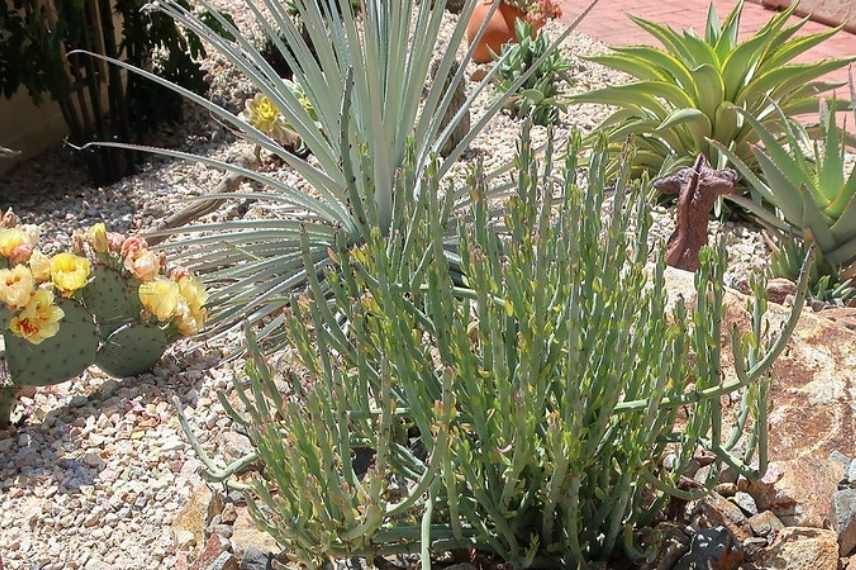
Senecio anteuphorbium, Dasylirion wheeleri, Opuntia, Agave desmetiana planted in very well-draining gravel substrate (© KM)
For which garden?
A small urban garden can be imagined in an exotic and dry style, provided it receives enough sunlight and warmth, of course, and if it is converted into a pot garden, to be wintered if the climatic conditions are not all met.
In a large garden treated entirely as a desert garden, as you may have guessed, you will need to live in the southern part of France, while avoiding the overly rainy Basque region for a large-scale layout. The climatic conditions in many departments truly allow for the creation of exotic gardens, where plants will find warmth, mild temperatures, and often calcareous soil conducive to their flourishing.
A dry exotic garden finds its place wonderfully around a pool, in a steep garden containing espaliers… Feel free to invest in these areas of relaxation or pathways that will thus be enhanced.
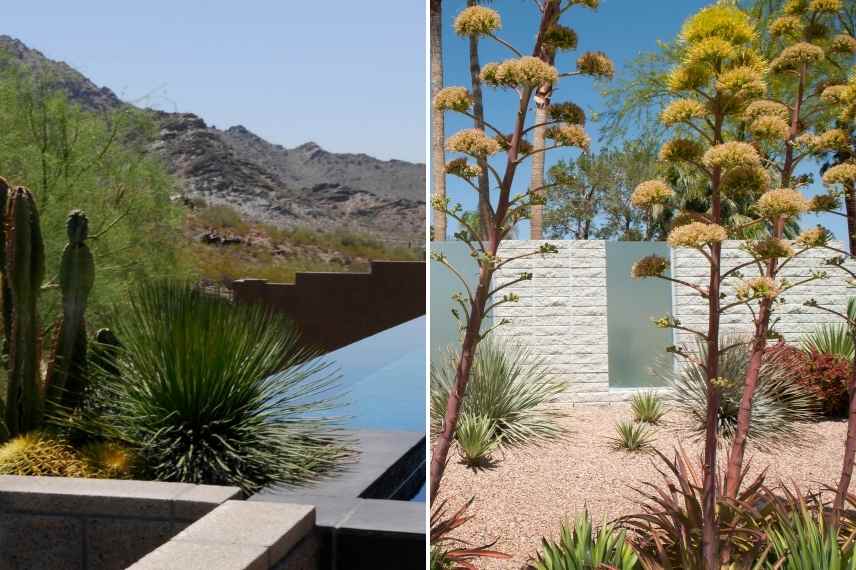
Two contemporary layouts of dry exotic gardens
A dry exotic garden can also find its place very well in the extension of a Mediterranean garden or a garrigue garden.
Finally, a roof terrace is quite suitable for a dry exotic garden, if only a low plant stratum is installed that can thrive in a very thin layer of substrate.
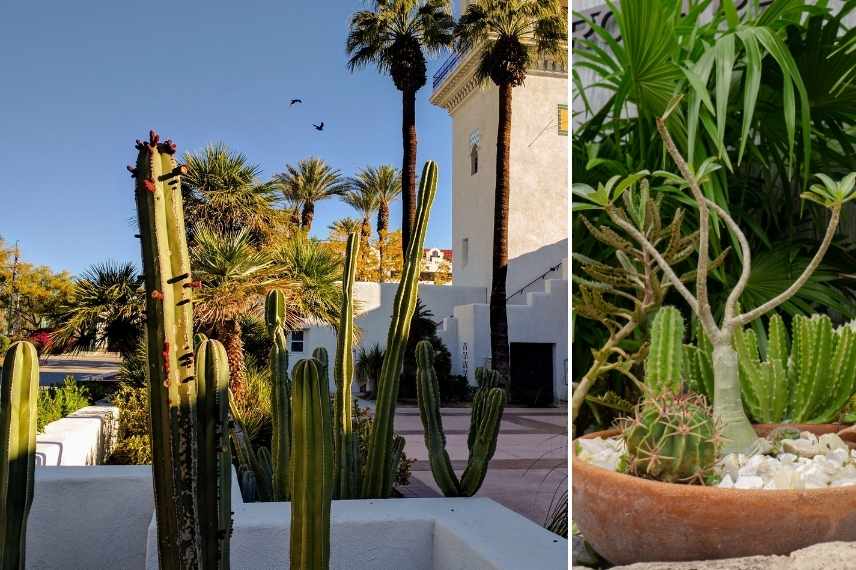
A dry exotic garden can perfectly find its place in a patio where plants will be grouped in containers or small pots
Read also
12 bushes for dry or free-draining soilThe atmosphere
Gravel garden, rockery, terrace, stone walls… the exoticism brought by a dry garden is associated with a visual of a garden where rock and stone contribute to recreating a desert-like environment.
Unlike a tropical exotic garden, moderation is key in a dry exotic garden: you can group cacti in threes, for example, but avoid overcrowding. It is truly interesting to leave space for minerals and pathways… They then take on real importance: they are often asymmetrical and free, and one can attempt geometric lines in a design garden with a minimalist style.
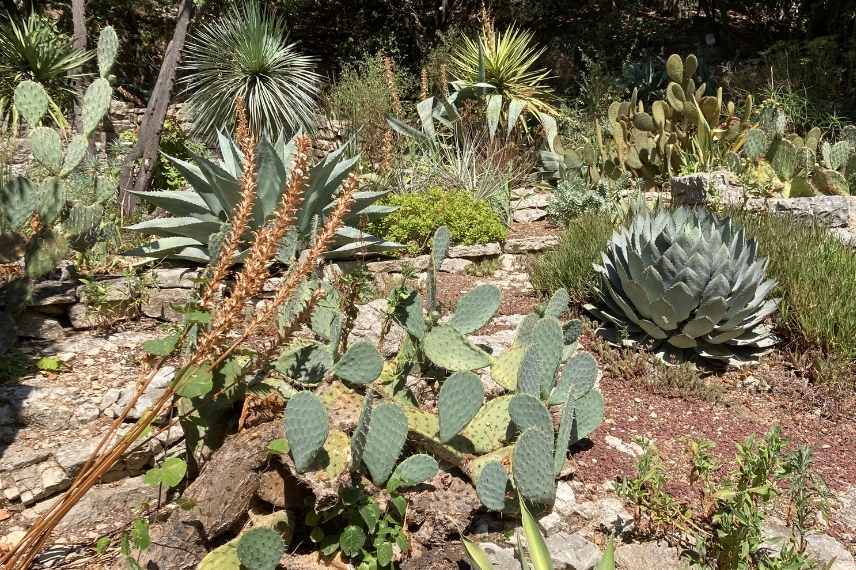
The slope of a terrain allows for beautiful compositions within a dry exotic garden (© Gwenaëlle David Authier)
In a dry exotic garden, we also aim to maximise light to evoke the sensation of warmth and desert!
Thus, we will strive to maintain a style where the extravagant and whimsical vegetation remains the star of the place. However, like in a tropical exotic garden, patches of bright pink-orange or blue (on walls, pottery) blend very well in this garden, especially in more subdued settings, such as a walled garden or patio.
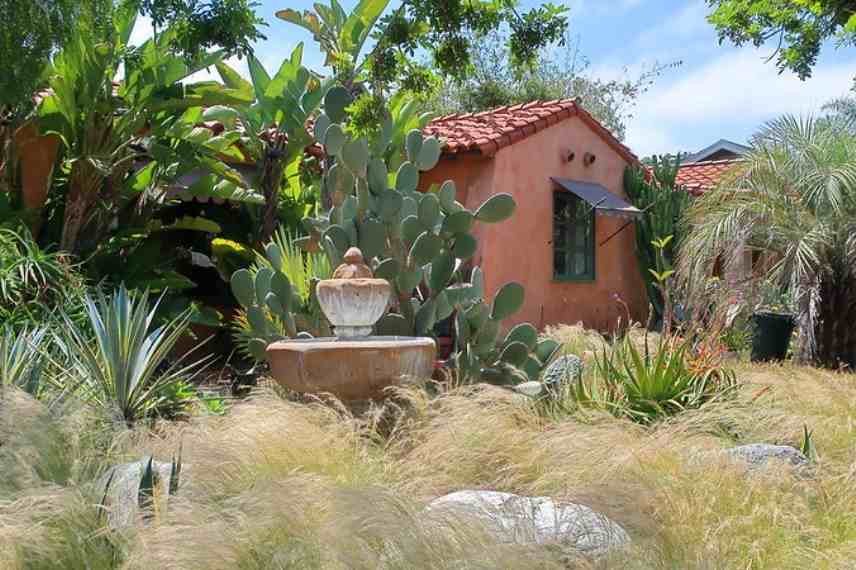
Mexican atmosphere for this dry exotic garden, featuring an Agave tequilana ‘Sunrise’, mass plantings of Nassella tenuissima, an Opuntia ellisiana, a Phoenix roebeleni, and Strelitzias nicolai (© KM)
The plant palette of the dry exotic garden
Plants will be selected from those that are most drought-resistant and thrive in very well-draining substrates. It is important to note that many cacti or succulents cannot tolerate temperatures below -5°C. To enable their installation in various regions, we will favour the hardiest plants from the existing palette. Trees, bushes, perennials, grasses, and ground covers should be intimately mixed with minerals, thus beautifully highlighted. They will help create layers of varying heights, adding volume and structure to your dry exotic garden.
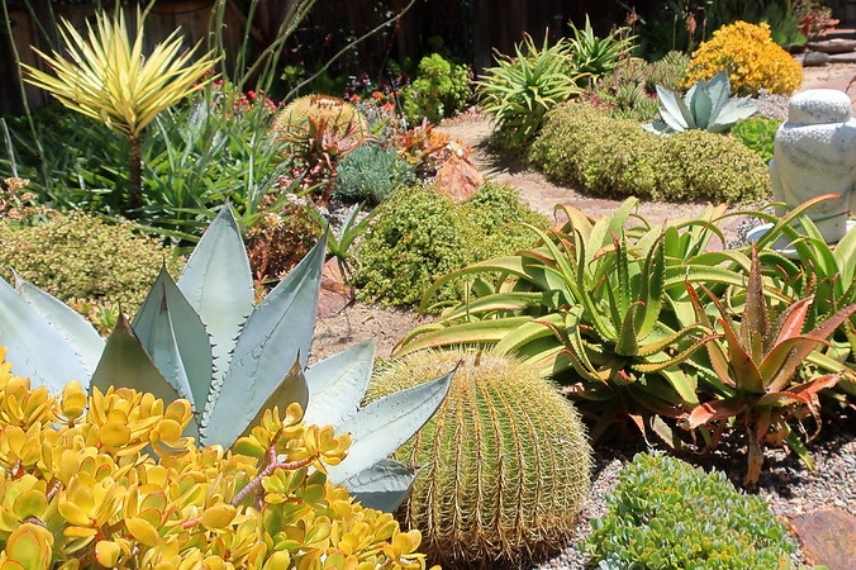
A lovely scene composed of succulent and cactus plants: Agave ovatifolia, Crassula ‘Hummel’s Sunset’, Echinocactus grusonii, and Furcraea foetida ‘Mediopicta’ (© Cultivar 413)
Make full use of the wide range of graphic exotic plants, either for their texture (cacti) or their volume (palms, grasses, ground covers, succulents): this creates a visual that is sometimes minimalist, as sought in a contemporary garden, and sometimes chaotic in a natural garden. Remember to mix solid and variegated foliage, blue and silver foliage with the more golden ones, some even purplish! Juxtapose the shapes of plants: the verticality of candle cacti, the rounded cushions of Echinocactus, the structural presence of palms, and the bizarre forms of Aeoniums to create a dynamic visual primarily composed of shades from chartreuse greens to greyed greens.
Four key types of plants are found in the dry exotic garden: cacti (spiky), succulents (fleshy), Agavaceae (pointed), and structural palms:
- Cacti: Opuntias robusta, Echinocactus, Ferocactus glaucescens, Echinocereus, Aporocactus, Pachycereus, Mammillarias…
- Medium and shrubby succulents: Sedums, Houseleeks, Aeoniums (Aeonium ‘Cyclops’), Senecios, Echeverias, Crassulas ovata, Kalanchoe thyrsiflora, Gymnocalyciums…
- Plants with pointed foliage: Agaves, Cordylines and Phormiums, Yuccas (Y. filifera, Y. brevifolia, Y. filamentosa…), Mangaves, Beschornerias, Dasylirions with more tapered leaves…
- Palms: Butia capitata, Chamaerops excelsa, Trachycarpus fortunei, Phoenix canariensis, Brahea armata (Mexican blue palm), Phoenix canariensiss, there are many…
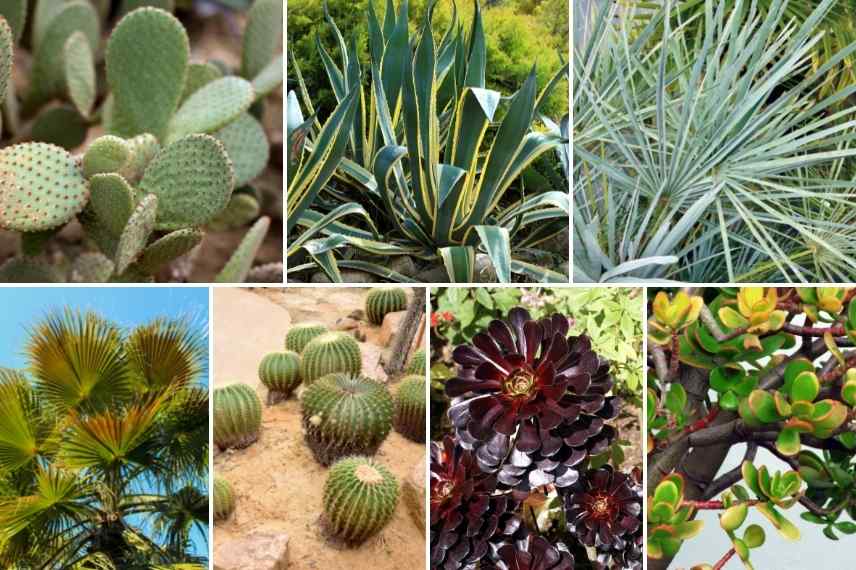
Opuntia, Agave americana, Chamaerops humilis, Trachycarpus fortunei, Echinocactus, Aeonium atropurpurea, and Crassula ovata
To this essential quartet of plants, you can add, according to your desires, your space… and your budget, the following plants:
- Tree-like plants: Cycas revoluta
- Rustic perennials and shrubs with an exotic appearance: certain Euphorbias (Euphorbia myrsinites, Euphorbia characias, Euphorbia pithuisa…), Hebes (H. rakaiensis), Thistles, Echinops, Caesalpinias…
- Ground covers: Sedums, Saxifrages, Lampranthus, Delospermas, Houseleeks, Ballotas, Carpobrotus…
- Low grasses: Fescues and Helictotrichons to create blue cushions, the wonderful Stipas tenuissima to accentuate the dry aspect of this garden. Some Miscanthus can also fit in.
- Introduced blooms sparingly, in spikes or conical bouquets, graphically pleasing: all Aloes (thraskii, cameronii, vera, arborescens, camperi…), the ideal plant for a dry exotic garden, but also Hesperaloes, Kniphofias, Puyas, Echiums candicans that bring beautiful verticality. The yellow flowering of Aeoniums ‘Cyclops’ is particularly stunning.
Prioritise a palette of restricted colours, such as yellow, orange, and white that blend well with dry exotic spaces. You can easily integrate Euryops with yellow flowers into Eschscholzia in orange.
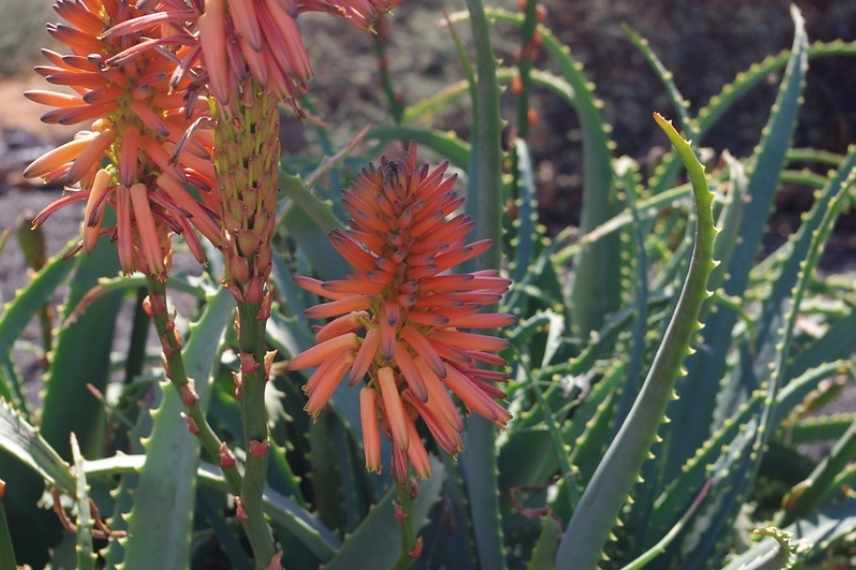
Aloes
- Shrubs and companion plants that are not typically exotic but blend very well: these are often plants with small leaves, fuzzy foliage, or greyish to silvery foliage, very resistant to sun and drought. You can add a few to easily and cheaply fill gaps: Ceanothus, rosemary, Santolines, Ajanias pacifica, Mulleins (Verbascum thapsus), Phlomis…
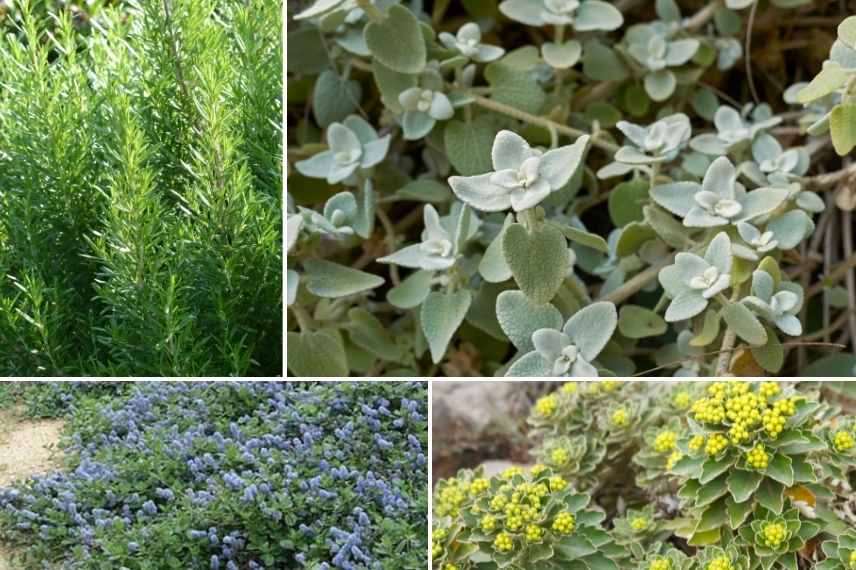
Rosemary, Ballota, creeping Ceanothus, Ajanias pacifica
Finally, the warmer your region and the larger your garden, the more you can afford to include sculptural or even giant plants that make a strong impression, such as dragon trees (Dracaena drago), magnificent candelabra euphorbias (Euphorbia canariensis, Euphorbia ingens), the astonishing Bougainvillea recurvata, the Pachypodium lameri (Madagascar palm), etc…
→ Read also: Invite agaves, yuccas, and cacti into your garden!
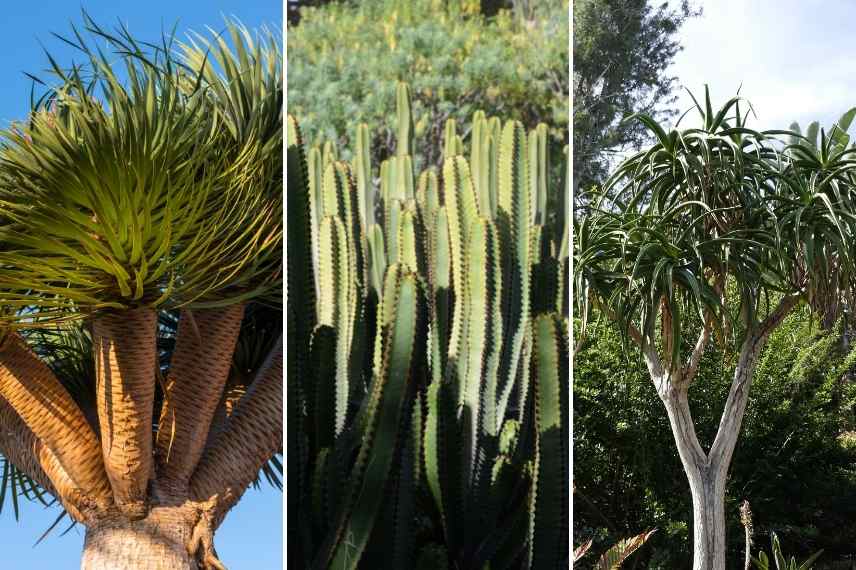
Dracaena drago, Euphorbia canariensis, Pachypodium
Refine the decor
At the material level, as we have seen, it is essential to insert stone, sand, gravel… in short, minerals into your garden. This contributes to a strong evocation of a desert landscape. Stone also helps to accumulate heat, releasing it at night, thus protecting the most delicate plants.
Try, as much as possible, to harmonise this mineral with your region by favouring local stone: in Provence and Occitanie, the use of limestone, in Brittany the use of schist and granite, in the mountains, lava stone, etc. All these stones evoke a New Mexico vibe and reflect light particularly well. They are used to create small walls, rockeries, add volume… Regardless of the stone’s colour, and even though light tones are traditionally used for reflection reasons, dark colours can be very original in atypical or design gardens, and accumulate even more heat in northern regions, for example. The use of red or black lava stone, basalt, or pumice is particularly effective.
Raw materials, from orange terracotta evoking warmth to grey concrete aiming for a more understated presentation, integrate very well with minerals and the graphic forms of succulents and other cacti. In a contemporary space, concrete or even steel will be particularly harmonious. Basins or jars made of clay fit naturally into a dry exotic atmosphere. A twisted dead tree trunk can even enhance a very desert-like setting, reminiscent of a western.
As for garden furniture, opt for pure lines or minimalist style: they will wonderfully complement this type of garden without overshadowing the exceptional plants you have installed.
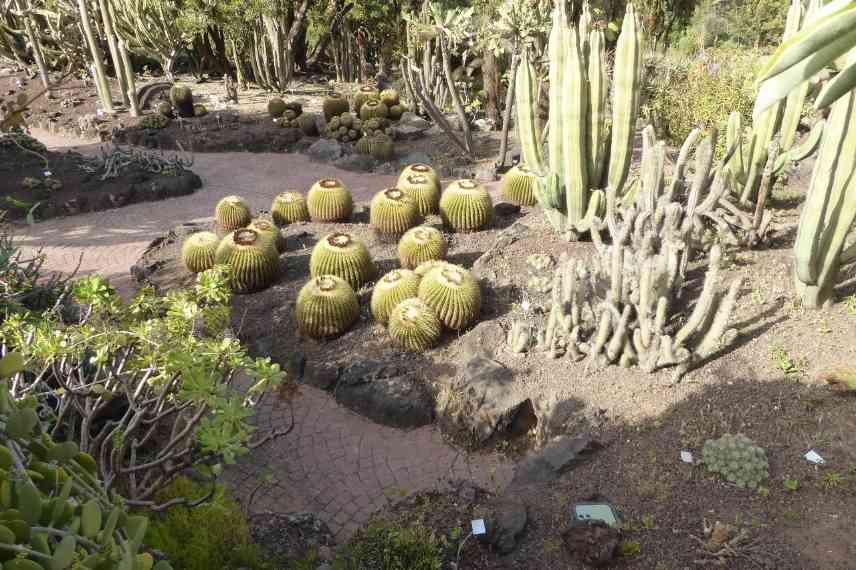
Use stone, create pathways. Here, at the botanical garden of Las Palmas (Canary Islands), volcanic stone literally enhances the cacti (© Gwenaëlle David)
Inspiring visits and readings
Lanzarote, the Canary Islands, the Cyclades… Volcanic islands have a semi-desert climate and stunning gardens that can inspire us at will. Hawaii and California, as well as Latin America, are destinations to draw inspiration from. Closer to home, the famous exotic garden of Monaco, the exotic garden of Eze, and the Mediterranean garden of Roquebrun in Hérault are magnificent dry exotic gardens in France, where the elevation allows for a stunning display of cacti, succulents, and palms.
Here are also some recommended books and reading suggestions to enhance your knowledge or discover this fascinating subject (these are French translations):
- “Desert Gardens” by Gary Lyons. Ed. Flammarion (2002) which lists around twenty exceptional gardens in California and inspires dreams.
- “Succulent Gardens” by Debra Lee Baldwin. Ed. du Rouergue (2008)
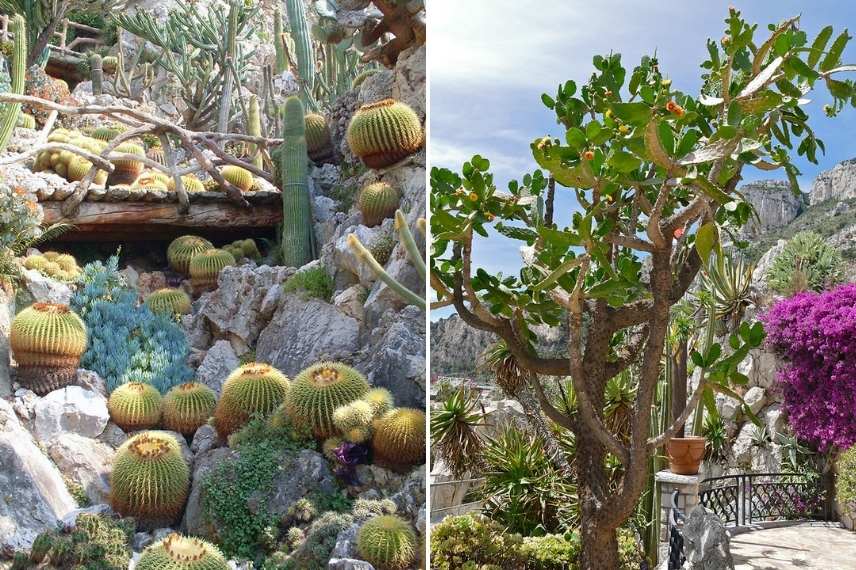
Exotic garden of Monaco (© jcvill2), on the right Opuntia Consolea falcata (© Bernard Dupont)
The hardiest plants for your dry exotic garden
A useful bonus for you!: a list of the hardiest varieties (down to -20°C) that you can install… almost anywhere, always ensuring to place them in a sheltered, sunny spot with well-draining soil. These plants will serve as a good starting point:
- Agave montana (down to -20°C)
- Numerous Yuccas (down to -20°C)
- Dasylirion texanum (down to -15°C) and Dasylirion wheeleri (down to -18°C)
- Palms: Butia capitata (-12°C), Chamaerops excelsa (-10°C), Trachycharpus wagnerianus (-18°C) and the versatile Hemp Palm
- Tradescantias (-10°C to -15°C)
- Beschorneria septentrionalis (-15°C)
- Cylindropuntia imbricata (-15°C) and Cylindropuntia spinosior (-20°C)
- Opuntia cyclodes down to -20°C
→ Learn more with our articles 10 hardy plants for an exotic dry garden, the hardiest palms, 5 cacti and succulents that withstand cold and drought, 7 hardy Opuntias to plant almost anywhere in France.
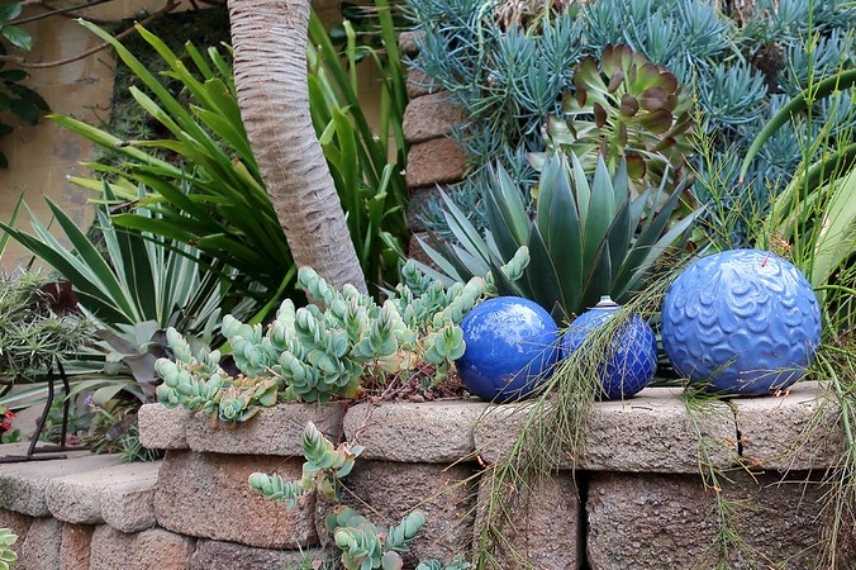
Kalanchoe marieriana, Senecio mandraliscae, Agave (© KM)
- Subscribe!
- Contents
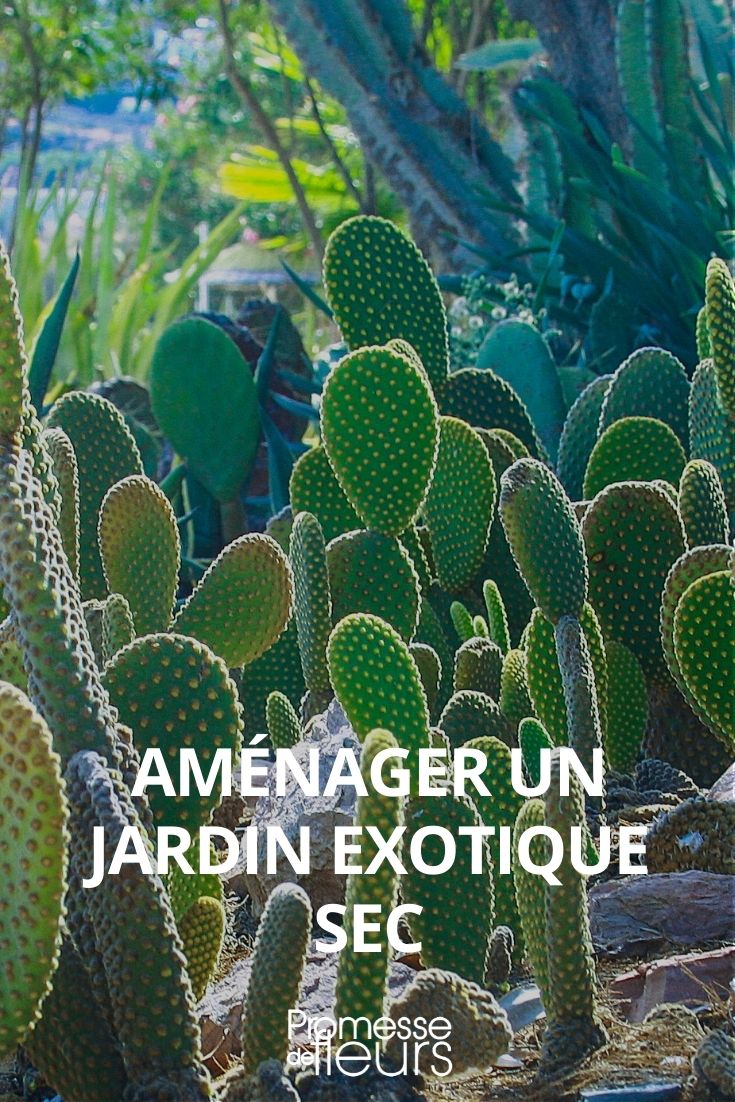































Comments